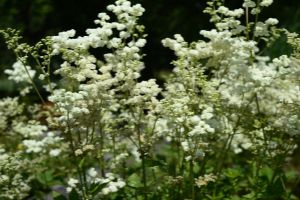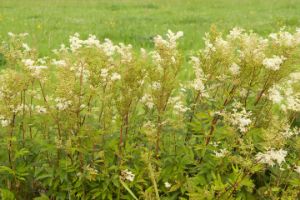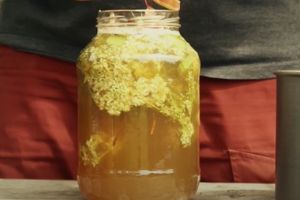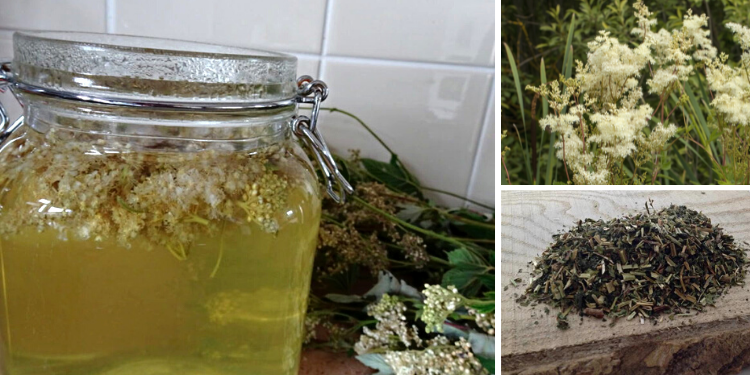Before there was Big Pharma and a Walgreens on every street corner, the pharmacy was found in the forest and your kitchen garden.
In fact, many of the drugs that you buy at your corner pharmacy are originally derived from plants.A great way to be prepared for when SHTF is to know which plants growing nearby have medicinal properties and how to use them.
When it comes to essential medicinal plants, meadowsweet, Filipendula ulmaria, is one to know.
Used for centuries in traditional remedies, once modern medicine discovered the active ingredient taking aspirin became more common than using herbs.
Meadowsweet Identification
While native to Europe and Asia, meadowsweet has been naturalized in North America. You can find this useful herb growing wild across the North Central and North Eastern United States.
Meadowsweet grows in damp areas. So, look for it in wetlands, forest edges, river banks, and moist meadows. You can easily identify meadowsweet once you know what you are looking for.
⇒ Learn How To Tell Apart Edible Plants And Their Poisonous Lookalikes
 The best thing to look for (and smell) is the flowers. They bloom all summer and into early fall, from June until September.
The best thing to look for (and smell) is the flowers. They bloom all summer and into early fall, from June until September.
You’ll see each individual flower is rather small– only measuring ¼ of an inch. But the delicate, creamy white flowers cluster together, creating a cloud-like appearance.
Once you see them, take a sniff. You should smell something delicious, reminiscent of honey, vanilla, and almond.
The plants themselves grow rather tall, ranging from 3-6 feet. The leaves are dark green on top with a whitish, downy underside. The edges are serrated, with some large serrations and others small.
How To Harvest Meadowsweet
The flowers are what are commonly used medicinally, though you can eat the roots and leaves as well.
Meadowsweet stays in bloom all summer, even into fall in some areas, so there is a large window to harvest.

There are some factors to consider when harvesting meadowsweet flowers.
First, ensure the place you are harvesting from has not been sprayed with any chemicals.
This can be a concern if you are wild foraging.
Alternatively, you can grow your own meadowsweet in your backyard.
⇒ Buy Your Own Meadowsweet Seeds Before They Are All Gone
You also want to make sure you are harvesting from healthy plants. Meadowsweet leaves can be susceptible to Triphragmium ulmariae, a bright orange-rust fungus. While it doesn’t harm the flowers, it’s better to harvest unaffected plants.
When looking at the flowers, be aware not all flowers in a cluster bloom at the same time. Harvesting younger clusters with unopened blooms is better than clusters with wilted blooms.
This is because meadowsweet flowers are moist and can be damaged by mold or fermentation. And this would affect your final medicine.
Once you have harvested your flowers and brought them home, it is a good idea to turn them upside down and give them a solid shake. This will help dislodge any critters that may have hopped a ride back home with you.
Then process your flowers right away to prevent fermentation. You can dry them in a dehydrator or use them fresh in tinctures.
Medicinal Properties
Meadowsweet has been a staple in medicine cabinets for centuries. Traditionally it was used to treat headaches, joint pain, and stomach issues.
And modern science has shown why meadowsweet is so effective at relieving inflammation and stomach upset. The active compounds in meadowsweet are salicylates and tannins.
 In 1897 Bayer chemical first derived acetylsalicylic acid from meadowsweet.
In 1897 Bayer chemical first derived acetylsalicylic acid from meadowsweet.
They named this compound aspirin, as the old scientific name for meadowsweet was Spiraea ulmaria. But while aspirin contains just one active compound, meadowsweet contains many different active compounds.
These compounds together do more than just aspirin does alone. That is why meadowsweet is used for more than just pain and headaches.
As mentioned, it can also help ease stomach problems. On the other hand, it also functions as a blood thinner, so people with bleeding disorders or ulcers should avoid it.
Many people also say salicylic acid is good for your skin. It can help with acne, sun damage, and other skin issues. It is commonly added to skin creams and lotions.
You can make tea with the flowers, tincture them or apply them topically for pain relief.
Culinary Uses
Not only is meadowsweet a powerful medicinal herb, but it also has culinary uses. You can eat the young leaves, either cooked or raw. They have a slightly medicinal taste, but it is possible to process them to minimize the bitterness.
Related: 10+ Wild Foods You Should Forage For This Summer
The blossoms are more common to find used in the kitchen these days than the leaves. Connoisseurs of fine alcohol will know that the flowers were traditionally used to flavor alcoholic beverages like mead, beer, and wine.

They can also be infused into other liquors, like gin.
Aside from alcohol, you can make a syrup that can be used in desserts, chilled drinks, and fruit salads.
You can use meadowsweet syrup to flavor panna cotta.
Meadowsweet Tea Recipe
All you need are one cup of water, 1-2 tablespoons dried meadowsweet, and a sweetener of choice.
Bring water to a boil. Pour boiling water over the dried meadowsweet and steep for five minutes. Then strain the tea and sweeten to taste.
You can consume one cup of tea up to three times a day. Children and people sensitive to aspirin or currently taking aspirin should avoid meadowsweet.
Meadowsweet has a long history of use in traditional medicine that is backed by modern scientific investigation. Great for headaches and upset stomachs, it is an essential addition to your herbal apothecary.
There’s no reason to wait for SHTF to start harvesting flowers for your medicine cabinet. The flowers are blooming all summer long. Head out now and look for the cream-colored cloud of flowers with the intoxicating scent.















Any thing that Claude Davis has anything to do with, I am interested.
Did some research on this plant and find it very interesting. Chemical constituents include salicin, flavone glycosides, essential oils, and tannins. In 1897, scientists in the firm Bayer used salicylic acid derived from meadowsweet to synthesise acetylsalicylic acid (aspirin), which was named after the old botanical name for meadowsweet, Spiraea ulmaria.
Keep in mind that willow bark also contains Salicin and can be used the same as the meadowsweet. Willow may be easier to find in some parts of the US than the meadowsweet.
when making anything from plants, salve, oils whatever, how long are they good for as in shelf life?
You will eat ze bugs.
You will be happy.
Yes, Your silly tinctures will keep you strong. Just enough to work in one of ze many re education facilities we have ready for you.
/End transmission.
That’s hilarious!
They are buying up the farms and the fields too.
well Alex, I expect you’ll be one of the first to be killed for your “supplies” along with your depraved attitude.
Better to get polyphenols for cellular function and detox along with the salicylate. Aspirin is highly refined like white flour and white sugar.
Mr. Bill gates is buying a excess amount of farm land. How much of it is in producion for food staples ?
In a SHTF situation where one doesn’t have time to wait flowers to dry, I was wondering if fresh flowers can be used? I’ve read in that case a tincture is used, although it doesn’t seem as easy to make as an herbal tea.
I love this kind of information, but that description isn’t complete, IMO. How tall? What do the leaves looks like? The stem? etc. So many things are used to correctly identify plants. (and better photos, if it’s common, shouldn’t be that hard to come by)
The botanical name was given. You can do more in depth research, and should.
This article was an Introduction to a Plant. It’s up to you to actually get up and do the work. Complaining makes you look weak, not wise.
I didn’t know much about the meadowsweet, seems like a great alternative to aspirin, so thank you for sharing.
Always do your own research so you become familiar with your subject. It’s what all we Herbalists and Herbal Alchemist do before we make a single formula.
Get into a true herbal school to be properly trained. School of Evolutionary Herbalism with Sajah Popham. I trained through 2020 and have certification in both Herbal Practitioner and Herbal Alchemy.
Get several good pictorial field guides NOT written by ai, to identity what you’re foraging and make 100% certain that is what you’re foraging.
Thoroughly study poisonous plants around you FIRST. Once you know them you’ll be able to forage easier. There’s a lot of look – alike poisonous plants out there so learn them well!
If in doubt DON’T! You’ll only make a fatal mistake once.